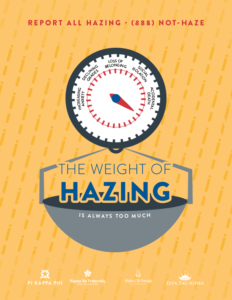Additional Educational Resources
While certainly not an exhaustive list, below are resources from some of our prevention educational partners to assist with your programming.
Prevent.Zone
Hazing Prevention Tips for the Team Leader – Looking for ideas on how to show your support during National Hazing Prevention Week? Share this video excerpt from Hazing Prevention 101™ – Athletics Edition with your team. (Download PDF Tip Sheet)
You’re Not Alone – “You’re Not Alone” is an excerpt from our Hazing Prevention 101™ – Athletics Edition, a 30 minute entirely online course that builds on what college students learned in Hazing Prevention 101. This online interactive course is tailored to the unique perspectives of student athletes and helps them recognize the signs of hazing; it reviews hazing laws and the effects of hazing, employing relatable videos like this to encourage, support, and inspire them to take action against hazing. Visit prevent.zone/hazing to learn more!
Hazing Prevention 101: Smart Steps 4 Staying Safe – Smart Steps 4 Staying Safe is a tool to train college students on how to prevent hazing before it starts and deal with hazing when it starts. Share it with every student you know as you prepare for National Hazing Prevention Week! #NHPW (Download Infographic)
Team Building Activities from Hazing Prevention 101 (PDF)
How Hazing Impacts the Family – “How Hazing Impacts Families” is an excerpt from our Hazing Prevention 101™ Course – College Edition is an evidence-based online course, reflecting best practices established by leading academics studying hazing. This one-hour awareness and prevention-based course teaches college/university students how to recognize, prevent and report hazing. Visit prevent.zone/hazing to learn more!
The Gordie Center
The mission of the University of Virginia’s Gordie Center is to end hazing and substance misuse among college and high school students nationwide.
- The Gordie Center’s prevention toolkit, with free videos and Instagram campaigns to download and use for free! https://gordie.studenthealth.virginia.edu/prevention-toolkit
- Information on alcohol overdose https://gordie.studenthealth.virginia.edu/learn/alcohol-education
- Information on hazing prevention https://gordie.studenthealth.virginia.edu/learn/hazing-education
The Piazza Center
The following resources are aimed at quality hazing prevention that will reduce the number and severity of incidents and increase student safety and wellbeing. Together, we can work towards a safer and more respectful community. (Additional Piazza Center resources)
- Piazza Center Horizontal Campus Hazing Model
The explanatory hazing model is a comprehensive view of the interplay of individuals’ engagement in hazing, intergroup dynamics, and group relationships in communities. The model is an organizing principle of the below monograph. Practitioners can use the model to inform prevention and interventions. - How to Use the Horizontal Hazing Model in Prevention
This guide supports campus-based and organizational professionals and volunteers to think about and apply the model at the individual, organizational, and community levels. - Employing Situational Strength in Hazing Prevention
The concept of situational strength (Meyer et al., 2010) suggests that environmental cues signal individuals and organizations about what behaviors are accepted and valued. - Strategies for Enacting Change at All Levels of the Horizontal Hazing Model
This guide reviews six individual, six organizational, and six community levels strategies to enact change to reduce hazing. - Steps to Develop an Organizational or Campus Amnesty Policy
The intention of Amnesty Policies is to remove barriers to a student or an organization seeking help. This guide is intended to help you think through fundamental questions, provide template language, and provide research to help drive the process. - Steps to Develop a Peer Mentor and Mentee Program
Peer mentoring, when done well, has admirable benefits including increase belonging, positive mental health, persistence, and retention to both organizations and campuses. This guide is intended to help campuses and organizations devise positive programs. - Detecting Signs of Hazing
While we now know more about why hazing occurs, practitioners often struggle with applying the “why” to understanding and detecting when hazing occurs. This guide is intended to help practitioners reflect on the early indications of hazing activity in student clubs and organizations. - Four Uses of Data for Hazing Prevention Program
Researchers are using the following descriptions to categorize campus data that informs hazing prevention programs: diagnosis data, implementation data, efficacy data, and data use. This guide defines four activities that help us improve hazing prevention. The following guide is taken from the study: Creating Communities of Practice to Address Campus Hazing and Hazardous Drinking in Fraternity and Sorority Life,. - Implementation Fidelity for Hazing Prevention Programs
Quality hazing prevention is a process that must involve rigorous assessment. This guide highlights the concepts of assurance, capacity, and saturation in building and implementing an effective hazing prevention program that can reduce the number and severity of incidents.While we now know more about why hazing occurs, practitioners often struggle with applying the “why” to understanding and detecting when hazing occurs. This guide is intended to help practitioners reflect on the early indications of hazing activity in student clubs and organizations. - Piazza Center Horizontal Campus Hazing Model
The explanatory hazing model is a comprehensive view of the interplay of individuals’ engagement in hazing, intergroup dynamics, and group relationships in communities. The model is an organizing principle of the above monograph. Practitioners can use the model to inform prevention and interventions.Citation:Veldkamp, S., Sasso, P. A., Biddix, J. P., Joyce, B., Perlow, E., & Maxwell, T., (2021). Horizontal campus hazing model. Penn State University: Timothy J. Piazza Center for Fraternity and Sorority Research and Reform. - Piazza Center Hazing Prevention Matrix
The prevention matrix is a review of hazing prevention and intervention literature on the efficacy of strategies for campuses and organizations. Future work is being conducted to add enhance the matrix including adding a policy section and summary of the current literature for each strategy. Practitioner can use the matrix to develop hazing prevention programs informed by research. - Evaluating Hazing and Related Behaviors, Intervention, & Prevention Efforts: A Solutions-Based Approach
The monograph (comprehensive review of literature) is an expanded view and understanding of hazing and hazing prevention from high school to college and college and associated student groups. An organizing principle of the monograph is based on the interplay of individuals’ engagement in hazing, intergroup dynamics, and group relationships in communities. Features to highlight in the monograph include a Hazing Prevention Matrix, rich practical Case Studies, and a comprehensive explanatory Model of Horizontal Campus Hazing (the Piazza Center Model, see the Matrix and Model below).The Piazza Center engaged Dr. Pietro Sasso, Piazza Center Research Fellow, and Dr. Bryan Joyce, Piazza Center Scholar, in January of 2021 to develop an exhaustive review of hazing prevention literature. In the fall of 2021, the Piazza Center partnered with Dr. Patrick Biddix, University of Tennessee, to expand this work as a result of the vision and support of the North American Interfraternity Conference. Dr. Emily Perlow, Worchester Polytechnic Institute was also added to the Piazza Center team. Citation: Biddix, J. P., Sasso, P. A., Perlow, E., Joyce, B. & Veldkamp, S. (2022). Evaluating hazing and related behaviors, intervention, & prevention efforts: A solutions-based approach. The University of Tennessee Knoxville, Penn State University Piazza Center, and North American Interfraternity Conference (NIC).
University Fraternity and Sorority Staffing Practices: Effect on Student Success
The preliminary findings in this report are an early indication that there is a potential relationship between staffing models and chapter level outcomes.
Educational Posters & Discussion Guides
Holmes Murphy Fraternal Practice Resources for Sororities and Fraternities
Holmes Murphy offers this educational information to provoke thought and discussion and it should not be viewed as a mandate or requirement. (Additional Holmes Murphy resources)
Amnesty Resources
Investigation & Sanction Resources
Hazing Prevention 101™ Course
Developed in partnership with PreventZone™ by AliveTek, this is an evidence-based, one-hour course utilizing best practices in awareness and prevention of hazing. Hazing Prevention 101™ — College Edition is designed for all students and provides a baseline for understanding the complexities of hazing.
Additional editions of Hazing Prevention 101™ available include:
- Athletics
- Fraternity & Sorority
- Creative & Performing Arts
- High School
Students at University of Central Florida taking the hazing prevention pledge
Additional Resources
Questions?
If you have questions, contact Todd Shelton, Executive Director.





